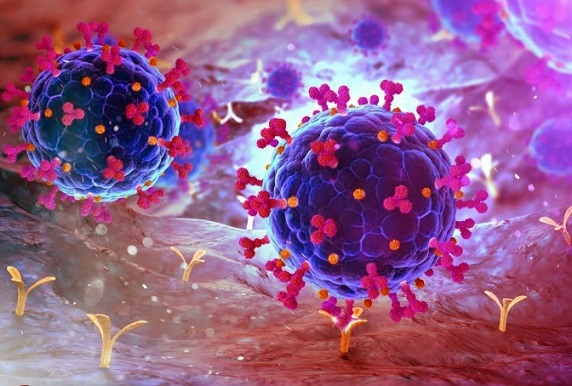Russian Scientist Uncover How SARS-CoV-2 Fusion Peptides Disrupt Host Cell Membranes
Nikhil Prasad Fact checked by:Thailand Medical News Team Jan 16, 2025 2 months, 4 weeks, 2 days, 21 hours, 21 minutes ago
Medical News: A groundbreaking study from researchers at the Research Institute for Systems Biology and Medicine (RISBM) in Moscow, Russia, has shed light on how the SARS-CoV-2 virus gains entry into human cells. The research explores the role of the FP1 segment of the virus's spike protein, which plays a crucial role in destabilizing cell membranes, ultimately aiding the virus in its entry.
 Russian Scientist Uncover How SARS-CoV-2 Fusion Peptides Disrupt Host Cell Membranes
Russian Scientist Uncover How SARS-CoV-2 Fusion Peptides Disrupt Host Cell Membranes
This
Medical News report delves into how SARS-CoV-2 uses FP1 to manipulate the stability of lipid bilayers in human cells, offering insights that could lead to better antiviral strategies.
The Science Behind Viral Entry
To invade a host cell, SARS-CoV-2 must merge its outer lipid envelope with the membrane of a human cell. This process is mediated by the spike protein, specifically its fusion peptides (FPs), which are highly conserved across coronaviruses. The FP1 region, consisting of hydrophobic amino acids, is crucial to this mechanism. FP1 inserts itself into the cell membrane, disrupting its structure and forming pores.
This study, utilizing advanced biophysical techniques such as atomic force microscopy (AFM) and electrophysiology, revealed that FP1 reduces the energy barrier for pore formation. This ability to create membrane defects explains how the virus bypasses the cell's natural defense mechanisms.
Key Study Findings
-Membrane Destabilization and Pore Formation
Using models of cell membranes, the researchers demonstrated that FP1 destabilizes lipid bilayers. The peptide caused calcein - a fluorescent dye encapsulated in synthetic liposomes - to leak out, indicating the creation of pores. This effect was more pronounced in simpler membranes made of dioleoyl phosphatidylcholine (DOPC) compared to cholesterol-rich membranes that mimic human cell membranes.
-Structural Changes
FP1 transforms from an unstructured state in water to a partially alpha-helical form upon interacting with lipid membranes. This structural shift enables deeper penetration into the membrane, where FP1 facilitates pore formation.
-Role of Cholesterol
Interestingly, cholesterol provided some resistance to FP1-induced disruption. In cholesterol-rich membranes, the likelihood of pore formation was reduced, and the membranes retained their integrity longer. However, even in these conditions, FP1 managed to induce transient, stable pores, suggesting that cholesterol delays but does not entirely block FP1's activity.
Force Measurements and Biophysical Insights
Through AFM, the team measured the mechanical force required to rupture membranes. They found that FP1 reduces this force significantly, making the membranes more prone to defects. The peptide also increased the rate of spontaneous pore formation, further emphasizing its destab
ilizing effect.
Implications of the Findings
The ability of FP1 to disrupt membranes has profound implications for understanding SARS-CoV-2 infection. By forming pores, the virus can bypass the initial stages of membrane fusion, allowing it to release its genetic material into the host cell more efficiently. The study also highlights the critical role of membrane composition, particularly the presence of cholesterol, in modulating FP1's effects.
Conclusion
This research provides a detailed look at how SARS-CoV-2's FP1 peptide manipulates host cell membranes. These findings underscore the importance of targeting viral fusion peptides in the development of new antiviral drugs. Understanding how FP1 interacts with different membrane compositions could lead to therapies that stabilize cell membranes, making it harder for the virus to invade.
The study findings were published in the peer-reviewed International Journal of Molecular Sciences.
https://www.mdpi.com/1422-0067/26/2/686
For the latest COVID-19 News, keep on logging to Thailand
Medical News.
Read Also:
https://www.thailandmedical.news/news/fusion-peptide-of-sars-cov-2-unveiled-as-a-key-agent-in-membrane-disruption
https://www.thailandmedical.news/news/key-positive-residues-in-sars-cov-2-fusion-domain-are-crucial-fo
https://www.thailandmedical.news/news/covid-19-news-karnataka-india-study-shows-that-niacinamide-enhances-cathelicidin-mediated-sars-cov-2-membrane-disruption
https://www.thailandmedical.news/news/sars-cov-2-spike-s-fusion-peptide-binds-to-negatively-c
https://www.thailandmedical.news/news/covid-19-news-cholesterol-and-ceramides-facilitate-sars-cov-2-spike-protein-mediated-membrane-fusion-which-can-be-inhibited-by-chlorpromazine
https://www.thailandmedical.news/articles/coronavirus
